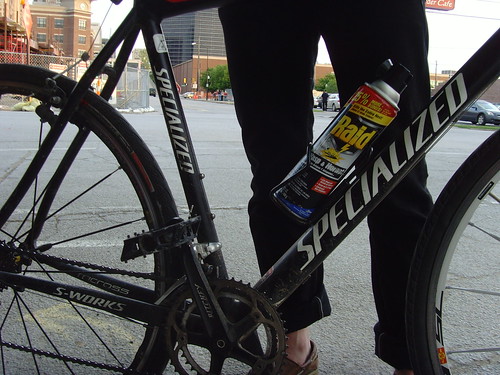We’re in Tulsa, where the news this past week has not been good. On Good Friday, five people on a public sidewalk were shot and three were killed; the story is that two men in a truck pulled up alongside, asked for directions, and then opened fire. Two men have been charged and there’s evidence that the shooting may have been racially motivated.
Last night, we got a walking tour from Stephen Lassiter, chair of Tulsa’s bicycle and pedestrian advisory committee, and writer of the Bike Walk Tulsa blog. Our destination was just over a mile away from where we are staying. Stephen, who has recently sold his car (his wife still has hers) in favor of a large, orange Yuba Mundo cargo bike (“It can carry 400 pounds. Why would I need a car?”), was unsure we were up for the walk. We assured him we’d weather the trek, and we all set off towards downtown.
Our first step was to cross under the freeway. Stephen chose an underpass that looked much like all the others. “Most people in Tulsa will never drive down this street,” he said, gesturing across the wide road. “The freeway is like the railroad tracks here,” he added once we got across. The side we’re staying on is North Tulsa, which is where more African Americans live — and where the Good Friday shooting happened. Our neighborhood has many, many empty lots where houses clearly used to be. I assumed this was the relic of some misguided urban renewal scheme of the 1970s, but we learned later that much of this area was burned down in 1921 during the biggest race riot the U.S. has ever seen — right in the midst of the oil boom that to this day provides the majority of the city’s vast, if lopsided, wealth.
Just across the freeway is Cain’s Ballroom, a famous music venue; right next door is the much newer Sound Pony, a bicycle-themed bar, with a number of bicycles parked outside along with a host of cars sporting bike stickers. We ran into Mike, one of the bar’s owners, who told us that he’d been attacked while on his bike two weeks ago — some people in a car had pulled up and asked for directions and then clocked him in the jaw — and showed us the can of Raid he now packs in his water bottle cage.
Mike pointed out the tallest building downtown — that building is the real dividing line in Tulsa, he told us. The street we were standing on used to be a bustling main street that connected the two halves of the city, but the skyscraper was built in the 1970s right in the center of it, physically dividing the wealthier area in the south of the city from the poorer area in the north. As we approached the tower, a steady stream of extremely well-heeled young women in cowboy boots and blousy hair walked past us in the street — the sidewalk was under construction. “Who’s playing at the Arena?” Stephen asked a group of them, and they startled and then stared straight ahead and increased their pace. After they were safely past us, one of them shouted “Miranda Lambert!” over her shoulder. “They’re all coming in from a long way away,” said Stephen, laughing. Even though central Tulsa’s population has boomed in recent years, he said, many people from the suburbs and elsewhere in the state are fearful of venturing downtown.
Tulsa does not seem to be a particularly friendly place to bike or walk, though there is an excellent, extensive trail system that has earned the city Bronze level classification from the League of American Bicyclists. Where the trails don’t go, the streets are wide and relatively empty of traffic, at least close in — the suburbs, where driving is the norm, are a different story. There’s a class gap in cycling as well, which a bike project called the Hub is attempting to address through their Adult Cycling Empowerment program to provide people who are in need with bikes, gear, and road safety education.
The bicycle movement has the potential to either break down class barriers, as it has to some extent in cities like Oakland and Los Angeles, or to build new ones, as it has unfortunately helped to do in Portland. I hope that as Tulsa’s budding bike community grows it continues to choose the former route.
Like what you’re reading? Check out the zines.

